« October 2012 |
Main
| December 2012 »
 November 29, 2012 | From John McGann: Jazz Improvisation
November 29, 2012 | From John McGann: Jazz Improvisation
We loved working with John McGann. As recent as this last spring, if you would have said we'd be conveying the Boston area music legend's expertise posthumously now, we couldn't have dreamed it would be true. Fortunately for the mandolin world, he left a well-documented legacy of information and tips from his decades of professional playing and private teaching experiences. We hope to revisit this periodically. His generous educational contributions will live on as we dig in. Enjoy the following article on jazz improvisation from his still active website.
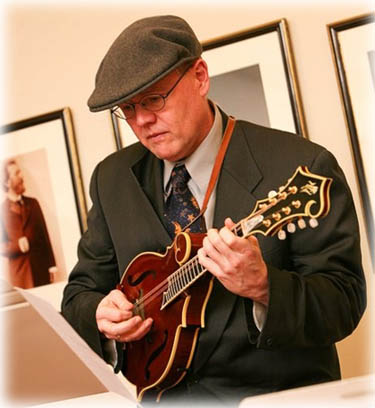
Jazz Improvisation; John McGann
As with any musical style, the word 'Jazz' really covers an huge stylistic area. Dixieland, Swing, Bebop, Modal, Fusion are all welded together under the 'jazz' heading, but each area has it's own practices and stylistic tendencies.Getting to know and understand the differences in this huge area of music is a lot of fun. Understand that each instrument has it's own rich tradition; and it is important to expose your mind to players of all instruments, not just your chosen one.
Learning to improvise in jazz is best begun with the common area shared by jazz, rock and roll, and country/bluegrass- which is "the blues." Learning the forms and chord changes usually encountered is a first step in getting a feel for improvisation.
Understanding chord/melody relationships is key to being able to develop coherent melodies that connect 'through the changes.' Knowing the notes available is like laying paints out on a palette- when you see what you have to work with, you can more easily apply the tools.
Listening and learning the vocabulary through transcriptions (or, transcribing the music yourself) are the only ways to really develop your language skills in an idiom.You can understand the chord/melody relationships, but have no sense of phrasing or how to put ideas together. Memorizing a solo so you can sing along with it, which will happen naturally the more you listen, is a good way to internalize the music.
If you are grounded in the fundamentals of harmony (knowing how basic triads are built, what the notes are ( i.e. D major= D F# A, 1 3 5), you can understand the concepts of extended harmony more easily ( i.e. Dm7b5/11= D F Ab C G, 1 b3 b5 b7 11). These choices affect the kind of lines you play, because the melodic material is dictated to a large extent by the harmony (chord) of the moment.
A good practice technique is to set your metronome to click on beats 2 and 4, and record a rhythm track. You can play it back and practice soloing. This allows you to have long explorations on a single chord, a good technique to learn a new sound.You can record 'just the hard parts' and practice them as a loop, or you can record entire tunes and practice playing through them.
Jamey Aebersold's series of music-minus-one type recordings are a fantastic source of practice material; they are top notch rhythm sections playing through tunes with you starring as the soloist. This is also a good source for educational materials for all levels of playing.
Link: Jamey Aebersold
Further
Remembering John McGann
Right hand considerations for flatpicking--John McGann
10 Questions for John McGann
Fitting in with triads
Posted by Ted at 6:19 AM
 November 22, 2012 | Best of JM: The virtues of sustain
November 22, 2012 | Best of JM: The virtues of sustain
Enjoy the popular archive material below.
From April 1, 2010 | The virtues of sustain"
We recently overheard some mandolinists talking about sustain on their instruments. One of them was actually complaining that he had too much sustain on his E and A strings, and was looking for a way to rid of it. Too much sustain? That's like one saying "I've got too much money."
Maybe there's a case for the imbalance of string sustain, say your D strings sustain more than your Gs, but a good mandolinist wishes he/she had the sustain of a clarinet like Pinocchio wishes he were a real boy. Then there's the bluegrass "motorboat" approach to picking, which is percussively akin to playing cards on clothespins snapped by bicycle spokes, and only slightly more melodic.
Our unabashed bias is for mandolin tone that retains its energy through long phrases, notes connecting from the end of one to virtually overlapping the beginning of the next. It's the wind driven sonority of a clarinet versus the decaying resonance of a xylophone. To get that you have to understand the basic mechanics of the plectrum.
- You cannot add sustain, you can only diminish the rate of decay.
- Good tone can only be because of a good pick stroke.
- One note must bleed into the next to connect a strand of notes into a phrase.
- Shortening the string adds energy (vibration), lengthening it reduces it.
- Maximum closed-fingered tone only happens at the sweet spot between the frets.
These are all principles that take conscious, intentional practice. At slower tempos, you have the ability to concentrate on each component, but they aren't any less important at higher speeds. This is why you need to practice good tone slowly, whole notes and half notes, before you worry about executing quality sustain at pyrotechnical speed.
Check out our October 2009 article, Whole(some) notes. In this we look at ways of building deliberate tone through whole notes.
You can never have too much sustain!

Further:
The Crack of the Bat
Forsaking the notes for the music
Starting with good tone
Using the picking hand to start Good Tone.
What makes a jazz mandolin?
Posted by Ted at 6:22 AM
 November 15, 2012 | Minor 7th Chord Streams. Under the hood.
November 15, 2012 | Minor 7th Chord Streams. Under the hood.
We introduced our up-the-neck chord patterns of minor 7th chords last week in the 2nd of our series of repeatable versions of 7th chords, or "streams." We trust you've had the chance to dig into them already and have noticed how easy they are to move up, down, and across strings, and in recognizable sequences. We're taken the time to show you a little more this week on how these relate to each other and repeat.
Recall we talked about inversions with our Dominant 7th Chord Streams, mentioning how you could label the forms based on the lowest sounding string (bass) in Root, 1st, 2nd, and 3rd inversions, designating the 1, 3, 5, and 7 of the chord. If you ever take institutional music theory, this is how you'd analyze and label chords. In jazz and pop slang, you would do this by calling out the bass note this way:
G7
G7/B
G7/D
G7/F
In order, these are Root, 1st inv, 2nd inv, and 3rd inv. As we mentioned, in mandolin chording, the bass note is kind of irrelevant because it's being sound out by a lower instrument in the ensemble. Our point was to let you know with 7th chords, there are only 4 inversions. If you were to go up a hypothetic neck of infinity, each of them would repeat again, 12 frets up (one octave).
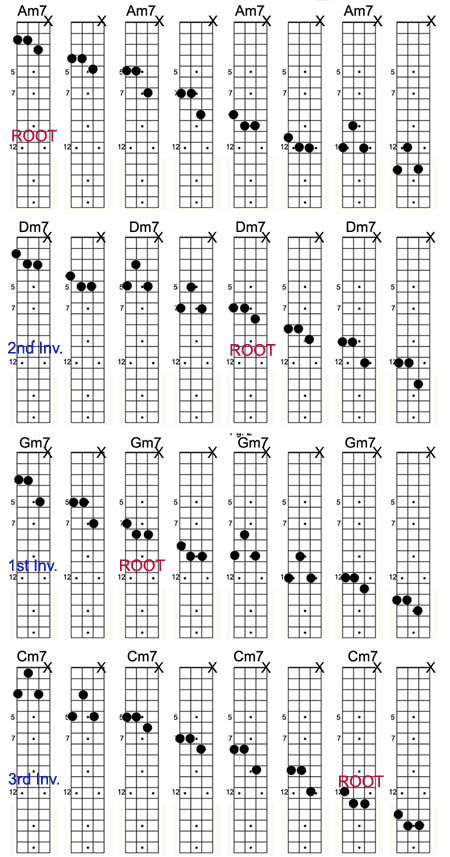
Looking at last week's m7 (with connecting) chords, each of the lines starts with a different of the four inversions. Remember, that's ONLY four inversions. You can move this around to all twelve keys, and it isn't that hard to do, practicing these either in the cycle of 5ths (Am7, Dm7, Gm7, Cm7, Fm7, Bbm7, Ebm7, Abm7/G#m7, Dbm7/C#m7, F#m7, Bm7, Em7), or simply moving the patterns up one fret, and then down one fret. You have all 12 possibilities there.
Boo yah!
The connection
Physically, you'll notice the connecting chords are simply the m7 pattern moved up two frets. We pointed out last week, they are the four inversions of the ii7 chord (Bm7 in the key of A minor). The classically trained musician will be reaching the arm in the air from the back of the class screaming, "What about the iim7b5? The iim7b5?" because technically in a minor key, the 5th scale degree is flatted. In A minor, the Bm7 chord would have a lowered 5th, F natural, but in jazz, it's more common, especially in modal jazz, that you'd keep the raised F#, unless you were using the chord to prepare for a V7 chord, the 'ii7b5-V7-I' cadence.
Don't get hung up about it, though. We've gone on record saying you can overthink minor scales and modes. We like to introduce all our exercises in minor as more a nebulous Minor/Dorian environment.
Here are some examples of well-known Modal Jazz standards:
So What
Impressions
Maiden Voyage
Cantaloupe Island
Little Sunflower
Black Narcissus
Freedom Jazz Dance
Footprints
Take Five
Milestones
Recordame
Invitation
Bolivia
My Favorite Things
Link to last week's PDF of the above for you to download and practice:
 Minor7thChordStreams.pdf Minor7thChordStreams.pdf
Further
Vamps. Minor modal
Static Changes: Connecting Chords
Minor Fun
Minor Blues: Fresh patterns
Connecting Chords
Posted by Ted at 11:56 AM
 November 8, 2012 | Minor 7th Chord Streams
November 8, 2012 | Minor 7th Chord Streams
We've had some fun the last two weeks creating V7 chord streams. We now want to take the same approach of using the four inversions of the V7 chord along with its "connecting" chord and apply it to a minor or Dorian mode song. We're a little ahead of ourselves labeling the different inversions. For now, just play through the following m7 chords, and all you need to know that each incarnation of the chord has a different member in the bass.
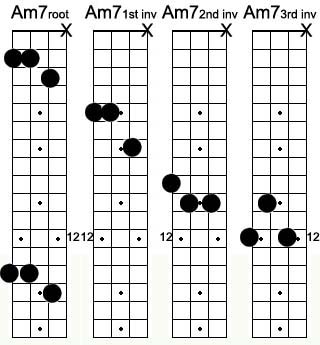
You could hypothetically just play the chords up and down the fretboard, but remember our important smooth voice leading rule. It's always best to limit chord movements to less than three fret jumps, so we want to inject some connecting chords. What we will add is the next chord up in the Dorian mode (more about our reasons next week), so the connecting chord is a 3-note inversion of the Bm7 chord (ii7).
Like we did with the V7 streams, on each successive row we're moving up the Circle of 5ths and showing you how you can start on a similar stream or cycle. Don't worry about the theory this week, we'll be looking under the hood soon. For now, just play. If you're really ambitious, dig up a lead sheet for Miles Davis' "So What" and apply them.
You'll be in comping heaven.
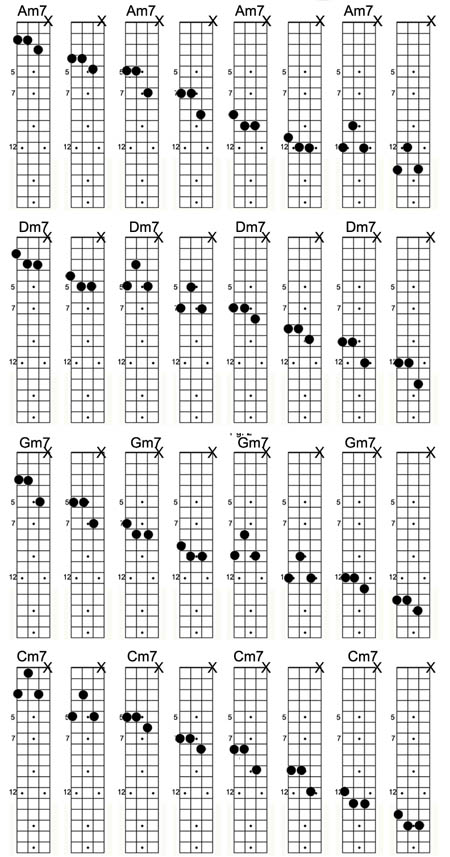
Here's a PDF of the above for you to download and practice:
 Minor7thChordStreams.pdf Minor7thChordStreams.pdf
Further
Vamps. Minor modal
Static Changes: Connecting Chords
Minor Fun
Minor Blues: Fresh patterns
Connecting Chords
Posted by Ted at 7:56 AM
 November 1, 2012 | 7th Chord Streams. Under the hood.
November 1, 2012 | 7th Chord Streams. Under the hood.
We presented some up-the-neck chord patterns last week that should put you down the path of making some very interesting variations on the V7 chord. We wanted you to just play, listen to the sound and get the variations into your fingers, and went so far as to encourage you to not dig too deep into the theoretical nature of the chords.
Admit it. They just sound sophisticated and cool.
This time, we actually do want to lift up the hood and check out the powerful engine underneath. Maybe you've already figured some of these things out, and if you're ahead of the game. Either way, you can still enjoy just playing.
Let's put on the lab coat. Fellow theory geeks, time to don your glasses held together with athletic tape.

Repeatable Inversions
On each line the 7th chords are four different inversions of the same chord. In traditional music theory, chords are identified by what's in the bass (lowest sounding pitch) of each chord. A Root position chord has the root, a 1st inversion has the 3rd, 2nd inversion has the 5th, and the 3rd inversion has the 7th. In the key of A (A, C#, E, G):
Root = A in bass
1st inversion = C# in bass
2nd inversion = E in bass
3rd inversion = G in bass
Notice in the first line the above inversions are listed in order. In the subsequent D7, G7, and C7 lines, the order ascends the same, it just starts on a different inversion. We've indicated the starting inversion with blue, and each root chord is indicated red.
The point is not to make you learn four different labels, however. The goal is for you to simply know there are four ways to play the V7 chord.
Connecting vs. Prep
On the first line, the alternating chord block between each V7 chord is based on 3 of 4 notes B, D, F#, A, either a Bm7 or a D6 chord. It doesn't really matter what you call it, because the function is the same. It's either just a simple connecting chord, a diatonic path to the V7, or it's a Dominant Prep chord. In our tonal universe, this chord sets up the dominant. It's not a Tonic. It's not a Dominant. It's simply a chord that "prepares" for the Dominant (V7).
What you label it doesn't matter, which is why we don't want to get too hung up on anything other than it's function. It prepares or connects. It stays in the chord's key.
Circle of 5ths
We were intentional in listing the chord lines in this way. A7, D7, G7, C7. They are ordered by the Circle of 5ths. Each chord is the V7 of the next chord. It progresses to the next in a circle that could literally go on infinitely if you continued in 5ths, and ended up where you started. We'd encourage you to immediately figure out for yourself the next in the sequence. Go on with the F7, Bb7, Eb7, Ab7, etc.
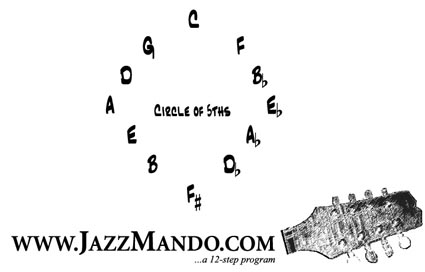
This is a practical tool in your chord arsenal. This is the bridge to Charlie Parker's "Scrapple from the Apple." It's also the progression for "I've Got Rhythm," and for that matter, any of the myriad of tunes based on "Rhythm Changes ."
Blues
We mentioned this last week, the 12 bar blues in its three chord simplicity can be supercharged with these progressions. A7, D7, G7, you've got the accompaniment for D blues right there. Use this for Miles Davis "All Blues."
Understand if you take the four chords we've already written, move them up a fret, then down a fret, you've learned them in all 12 keys. Don't worry about what the inversion is, just start learning the relationships between the chords.
We've reduced the exercise to a two page PDF:  7th Chord Streams 7th Chord Streams
Enjoy!
Further
Functional thinking
Jazz Primer: Harmonic Function
Vamps Pt 3. Scurry Dominants
Connecting Chords
Rhythm Changes :
Posted by Ted at 1:38 PM

Disclaimer: In the 'Information Age' of the 21st Century,
any fool with a computer, a modem, and an idea can
become a self-professed 'expert." This site does not
come equipped with 'discernment.'
|



